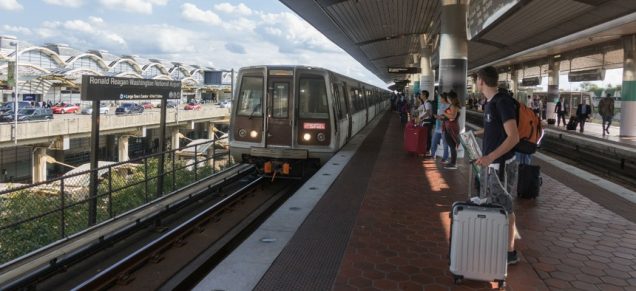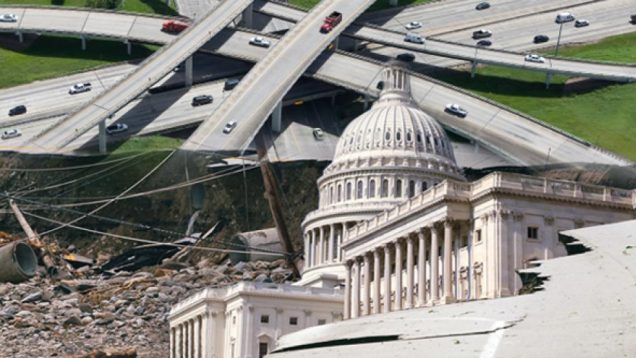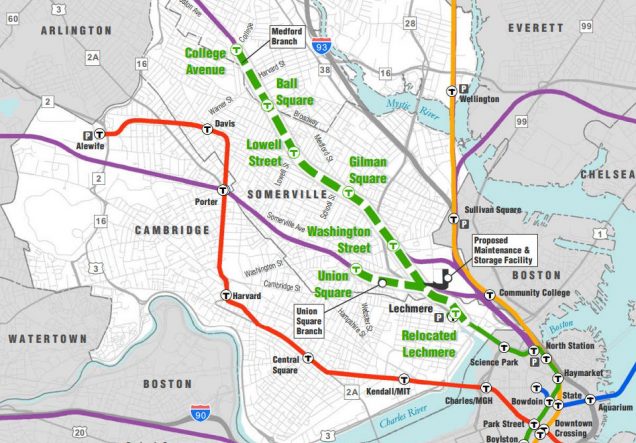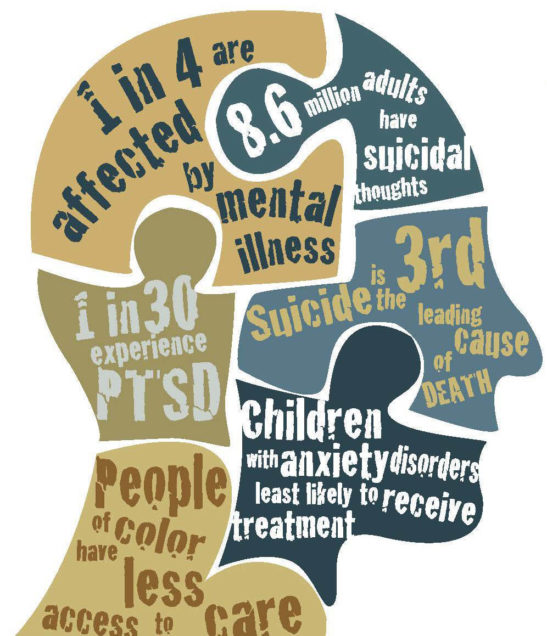Category: Budget & Appropriations
Running Out of Room: The Right to Shelter in Massachusetts
On August 8, 2023, Massachusetts Governor Maura Healey declared a state of emergency because state resources were insufficient to comply with the Commonwealth’s right to shelter law. Although the law has been in place for 40 years, a rapid increase in the number of people requesting shelter and the declaration of a state of emergency has inspired new debates and tensions around the right to shelter. To maintain the spirit of the law but not overburden the Commonwealth, compromises must be made to continue the legacy of the right to shelter.
Governor Dukakis & Right to Shelter
In 1983, Massachusetts closed its mental hospitals, which along with rising drug use, left people homeless and sleeping in the streets across the state. In response, Governor Michael Dukakis filed legislation guaranteeing shelter for every homeless family in the state. Ten months later he signed the ‘right to shelter’ law.
The emergency assistance program, colloquially known as the right to shelter law, is meant to protect children from homelessness if their parents fall onto hard times. The law guarantees shelter for families with children and pregnant people without children. Under the law, the state must quickly provide shelter and basic necessities to families who have nowhere else to stay.
Governor Healey & Current Crisis
On July 31, before the state of emergency, a group of Massachusetts legislators released a letter urging the federal government to streamline the process for work authorizations so immigrants can begin working and stop depending on the state. Employment authorization had a wait time of six months or longer, thus forcing immigrants to rely on the state as they cannot legally work without authorization.
On August 8, Governor Healey declared a state of emergency after months of rapid escalation of families seeking shelter. Along with the state of emergency, the state reported spending nearly $45 million per month on programs to help families eligible for emergency assistance. As of October 2023, nearly 7,000 families were in emergency shelter and about half of those in shelter were children. The governor said the state would be unable to accommodate new families by the end of October 2023. Despite the inflated numbers and costs, the governor made it very clear that the law was not ending, but Massachusetts needed federal assistance, sites to house people, staffing, and funds to continue doing the work of sheltering those in need.
 Massachusetts is the only state that has a right to shelter. The most similar law is a New York City consent decree that guarantees all unhoused individuals—not just families—shelter within city limits. The city’s right to shelter law has also been facing criticism as an increase in unhoused people and an influx of immigrants has overburdened that system as well. In response to the surge of families seeking shelter, New York City Mayor Adams suspended some components of the law, Governor Kathy Hochul declared a state of emergency, and subsequently received $104.6 million federal funds in response. Much like what happened in New York City, Mayor Healey is attempting to solicit federal assistance to mitigate the rapid increase in those seeking shelter and the amount of state resources being allocated to handling the crisis.
Massachusetts is the only state that has a right to shelter. The most similar law is a New York City consent decree that guarantees all unhoused individuals—not just families—shelter within city limits. The city’s right to shelter law has also been facing criticism as an increase in unhoused people and an influx of immigrants has overburdened that system as well. In response to the surge of families seeking shelter, New York City Mayor Adams suspended some components of the law, Governor Kathy Hochul declared a state of emergency, and subsequently received $104.6 million federal funds in response. Much like what happened in New York City, Mayor Healey is attempting to solicit federal assistance to mitigate the rapid increase in those seeking shelter and the amount of state resources being allocated to handling the crisis.
Debates Over Right to Shelter
Since the beginning of 2023, there has been increased criticism of the right to shelter in Massachusetts. People claim the housing crisis paired with the surge of immigrants entering the state have overburdened the emergency assistance system. Further, they claim the right to shelter has turned Massachusetts into a ‘migrant magnet.’ Overall, critics see the right to shelter as an outdated relic that cannot keep up with current demands. These criticisms have come with calls for the law to be amended, suspended, or altogether repealed.
Rep. Peter Durant (R-Worcester), is among the most vocal in expressing criticisms of the right to shelter law. Durant firmly believes the right to shelter law is being overrun by migrant families asking for assistance and suggested adjusting the law to excluding immigrants from receiving aid under this law. On September 14, 2023, Durant proposed H.4561 (An Act Ensuring Fair Housing for Homeless Families) to amend the right to shelter law to only apply to U.S. citizens. He is joined by twelve other petitioners, and the bill is still in committee as of October 2023.
Despite the criticism, there is still sizable support for the law amidst the crisis. Sarang Sekavat, chief of staff at Massachusetts Immigrant and Refugee Advocacy Coalition, testified, “The idea [of the law] has always been to help out families and really to make sure that children aren’t suffering when their parents fall on hard times, and that’s exactly what we’re seeing right now.” 76% of Massachusetts residents, especially immigration and housing advocates, agree with Sekavat and believe the law is operating exactly as it was meant to and exemplifies the character of Massachusetts.
Moving Forward
Although the current housing crisis is putting the right to shelter law under intense scrutiny, the law is functioning as intended. The law was passed with children in mind and with the goal of ensuring no child had to sleep on the streets of Massachusetts. There is a rising need for housing, influenced by the housing and immigration crises, and many children do not have housing. The law has been an important part of Massachusetts’ identity for four decades, and to repeal it now when people need it most would be to go against the very nature of the Commonwealth.
On the other hand, concessions may need to be made for the well-being of the Commonwealth. If the Commonwealth overextends itself and its resources to meet rising needs, it may jeopardize the longevity of the right to shelter and similar programs. In 1983 there was no way to predict the amount of people seeking shelter in 2023. Now, there is no way to predict the trends in people seeking shelter, particularly if it will continue to increase or when it will stop. If Massachusetts will run out of room imminently, difficult decisions must be made to address the need for shelter with the availability of resources and housing.
The path forward must be a mix of aspiration and reality. Massachusetts must solicit support from the federal government with financial assistance and an expedited process for work authorizations. Further, Massachusetts must look inward to equitably share the responsibility among all towns and cities, as well as plan to increase the housing available for those in need. Additionally, the Massachusetts Legislature could pass legislation to address the housing crisis, including implementing rent caps and moratoriums on evictions. To continue the legacy of the right to shelter law, the Massachusetts and federal governments must work together to address the current crisis and preserve the law for those who need it in the future.
 Juliana Hubbard anticipates graduating from Boston University School of Law in May 2025.
Juliana Hubbard anticipates graduating from Boston University School of Law in May 2025.
Shifting Baselines are a Double-Edged Sword: Why Climate Advocates Must Honor Our Environmental Laws In Shaping Climate Policy
In his 1970 state of the union address, Richard Nixon said, “we still think of air as free. But clean air is not free, and neither is clean water. The price tag on pollution control is high. Through our years of past carelessness, we incurred a debt to nature, and now that debt is being called. The program I shall propose to Congress will be the most comprehensive and costly program in this field in America’s history.” President Nixon later signed bipartisan legislation establishing Environmental Protection Agency.
EPA efforts implementing laws such as the Clean Air Act and the Clean Water Act have greatly reduced pollution throughout the United States. Enforcement of the CAA has reduced aggregate national emissions of the six common pollutants by 73 percent. At the same time, gross domestic product grew by 324 percent. The CWA has had a rockier implementation – Flint Michigan still doesn’t have clean water – but has nevertheless had a significant impact on reducing water pollution.
United States. Enforcement of the CAA has reduced aggregate national emissions of the six common pollutants by 73 percent. At the same time, gross domestic product grew by 324 percent. The CWA has had a rockier implementation – Flint Michigan still doesn’t have clean water – but has nevertheless had a significant impact on reducing water pollution.
Unfortunately, Americans are already forgetting that clean air and clean water is not a guarantee or a constitutional right, due in part to the phenomenon known as shifting baseline syndrome. It suggests that something that was abnormal in the past, becomes the new normal, or baseline, for a generation of individuals, who then collectively forget the past baselines.
First explained in 1995, this cognitive theory has gained traction in the climate community to explain public antipathy towards action on climate change. It suggests that as average temperatures and associated climate effects slowly increase over time, individuals will fail to recognize the danger that the climate crisis poses, and collective action may fail to materialize as a result. Climate activists fear that no specific event will motivate action similar to the environmental crises in the 1970’s, and like a lobster in a pot of boiling water, we won’t realize what is happening until it is too late.
 Shifting baselines, however, are not limited to present climate effects, but also work to undermine public support for current environmental laws and regulations that continue to reduce pollution in the present day. In 1995, for example, EPA embarked on an ambitious project to cure 400 years of environmental degradation and make the Charles River swimmable and fishable again, pursuant to its authority under the Clean Water Act. While those goals have not fully been achieved – EPA does not advise swimming on some days, and fishermen can only catch, then release fish – the monumental efforts have reduced source pollution from raw sewage flows and have led to a 99.5% reduction in source contributions to the river.
Shifting baselines, however, are not limited to present climate effects, but also work to undermine public support for current environmental laws and regulations that continue to reduce pollution in the present day. In 1995, for example, EPA embarked on an ambitious project to cure 400 years of environmental degradation and make the Charles River swimmable and fishable again, pursuant to its authority under the Clean Water Act. While those goals have not fully been achieved – EPA does not advise swimming on some days, and fishermen can only catch, then release fish – the monumental efforts have reduced source pollution from raw sewage flows and have led to a 99.5% reduction in source contributions to the river.
As a transplant to Boston, I was shocked to learn that the Charles has such a toxic history. And it is possible, if not probable, that an entire generation of Bostonians will grow up taking this privilege for granted. It may even be easy, based upon the unqualified success of the river cleanup, to forget the substantial sacrifices made and costs incurred in restoring the Charles.
This intergenerational failure to maintain understanding of past action in an environmental context may present a barrier to action on climate change. If the public discounts past costs to safeguard our water and air or the costs of maintaining environmental quality, the harder it will be to take new action. The public will not be ready to accept the significant costs required to tackle the climate crisis.
This is why it is imperative for climate advocates to not discount our existing environmental laws, but to actively celebrate their successes. It is incumbent on our present leaders and policymakers to stress how far we have come to clean the environment. They must frankly and openly discuss the means we took to get here. And they must stress that it is in our power to once again make the difficult decision to invest time, energy, and significant sums of money to clean our environment. We are not working from a blank slate in the climate fight.
Unfortunately, it seems that even our legislators pursuing climate action view climate solutions as separate and distinct from the long history of environmental action. For example, the Green New Deal discusses the World War II and New Deal mobilizations but fails to mention the bedrock environmental laws of the 1970s or the decades of subsequent pollution abatement.
We face severe environmental and public health challenges. We are not on track to keep global temperatures below 2 degrees Celsius. Sea level rise threatens our coasts. Ocean acidification will virtually eliminate all coral reefs and their priceless biodiversity and threaten coastal fishing communities’ livelihoods. It may be easy to abhor the cost of action, but we have not only known for fifty years of the cost of a clean, resilient, and sustainable environment, we accepted those sacrifices. It is time to embrace that history, rather than run from it.
 Joshua Williams anticipates graduating from Boston University School of Law in May 2021.
Joshua Williams anticipates graduating from Boston University School of Law in May 2021.
There’s No Such Thing as Sex Without Consent
On January 16, 2020, the Massachusetts Senate passed S.2475 “An Act Relative to Healthy Youth,” which creates mandatory guidelines schools must follow when implementing their sex education curricula. This does not require schools to adopt a curriculum, and there is an opt-out provision for parents who do not wish their children to receive this education. Still, the bill requires medically accurate information be shared, that a comprehensive view of sex education be taught that goes beyond abstinence-only education, and, perhaps most importantly, the bill requires schools teach students about consent, boundaries, and healthy and safe relationships. Unfortunately, the 2020 legislative session came to an end with the bill stuck in the House Committee on Ways and Means.
Sex Education in the United States
In the United States, sex education started as a movement to discourage masturbation in young men, and encourage abstinence before marriage. While sex education started to spring up more in public schools during the 1920s, it wasn’t until the 1950s when the the American Medical Association and public health officials first advocated a standardized curriculum. The 1960s saw religious and conservative groups attack sex education, asserting that teaching youths about sex would make sexual engagement more likely. In the 1980s, the HIV/AIDS health crisis led many officials, backed by federal funding, to require abstinence-only sex education in schools.
before marriage. While sex education started to spring up more in public schools during the 1920s, it wasn’t until the 1950s when the the American Medical Association and public health officials first advocated a standardized curriculum. The 1960s saw religious and conservative groups attack sex education, asserting that teaching youths about sex would make sexual engagement more likely. In the 1980s, the HIV/AIDS health crisis led many officials, backed by federal funding, to require abstinence-only sex education in schools.
By 2009, the federal government was putting $170 million per year into these George H.W. Bush era programs. Under President Obama, the federal government continued funding abstinence-only programs, but also introduced a more comprehensive sex-education approach in an effort to reduce teen pregnancy. The Trump administration then gutted the Teen Pregnancy Prevention Program, restricting federal funding to abstinence-only programs.
On the state level, 37 states require sex education programs to cover abstinence and 27 of those require prioritizing abstinence. 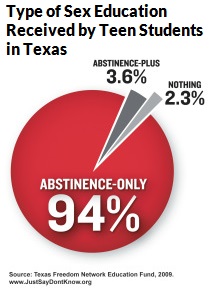 Students who attend schools with less funding are more likely to receive abstinence-only education, leading to a correlation between socioeconomic status and an increase in teen pregnancy, STDs, and sexual violence.
Students who attend schools with less funding are more likely to receive abstinence-only education, leading to a correlation between socioeconomic status and an increase in teen pregnancy, STDs, and sexual violence.
Currently, only 8 states and Washington D.C. require students learn about consent. Of these, seven passed their requirements within the last four years. In just 2019, four jurisdictions passed consent education requirements and nine more states introduced similar legislation.
The Importance of Consent Education
Sex is not sex without consent – it’s rape.
A Columbia University study indicated that those who received training in how to refuse sexual advances were less likely to be sexually assaulted in college. There was no similar correlation between abstinence-only sex education and sexual assault. Equipping students with the ability to set their own boundaries is important, but teaching students to recognize and respect those boundaries in others is just as necessary to prevent sexual violence. Merely giving students the tools to help them potentially get out of a situation they don’t want to be in is not enough, because it does not express the importance of consent in sexual interactions. As long as people fail to recognize and respect the consent of others, there will always be uncomfortable or dangerous situations to try to get out of – it’s mopping up the water from the overflowing sink without turning off the tap.
For young children, consent education reassures them that they have a say in what happens to their bodies (something many children are not aware of), and it teaches them to respect other peoples’ choices, as well. As students age, understanding consent as a concept allows them to form fundamental understandings of what healthy relationships with others look like. Beyond a reduction in sexual violence and misconduct, these are important life-skills that reach far beyond sexual situations.
The Opposition
There is still support for abstinence-only sex education in many parts of the country, and consent education is often seen as condoning sex. Unfortunately, resisting consent education works against abstinence-only goals by not providing students with the tools needed to establish healthy boundaries and respect for each other’s physical space. These skills are key for both those who wish to remain abstinent until marriage and for those who engaging in sex.
condoning sex. Unfortunately, resisting consent education works against abstinence-only goals by not providing students with the tools needed to establish healthy boundaries and respect for each other’s physical space. These skills are key for both those who wish to remain abstinent until marriage and for those who engaging in sex.
Some of those who oppose consent education, especially for younger students, worry that the subject matter may be too mature, but consent education does not have to be presented along with sex education for younger students to be effective. Consent is ultimately about permission, which is a concept children can easily grasp. For example, sharing and borrowing things involves consent. Additionally, teaching consent around hugging is a way to instill physical boundaries in children.
Looking Forward
West Virginia, Rhode Island, and D.C. have all adopted comprehensive legislation on consent education. These states require consent education based on the student’s age, introduce the concept of consent to younger children while assuaging some of the opponent’s concerns.
Harvard’s Graduate School of Education created a consent education model based on suggestions from educators across the country. The model proposed laying a foundation of consent and boundary building behaviors in younger children, and then including sex in the conversation for older students.
The Harvard model also recognizes that consent education should not be limited to straight boys but that anyone can perpetrate sexual violence and misconduct. Just as socioeconomic factors play a role in who receives comprehensive sex education, individuals holding certain identities are disparately impacted by sexual violence and students need to be aware of these inequities as they learn to navigate sex and consent.
Every school should adopt some form of consent education both before and during sex education. Otherwise, we will continue to endure a society that fails to respect the boundaries and choices of others. The Massachusetts Senate passed bill was a step in the right direction. Hopefully, the bill will become law during this new legislative session.
 Alexa Weyrick anticipates graduating from Boston University School of Law in May 2021.
Alexa Weyrick anticipates graduating from Boston University School of Law in May 2021.
The Real Cost of COVID-19: The Fractured Health Care System
The coronavirus (COVID-19) pandemic has uprooted the very foundation everyday life, turning socialization into a moral evil, and weaponizing safety precautions as political propaganda. These clear immediate costs, amounting in the loss of life, jobs, and social pleasures, are merely the surface to a rather elaborate system of institutional market failures that are bound to follow. While the coronavirus promptly began a long-awaited economic recession, forcing more than 31 million people in the United States to file for unemployment insurance, there has been a catastrophic loss of employer based health insurance coverage for many individuals, leaving only those who are eligible and qualified to move over to Medicaid or other subsidized health insurance policies. Unfortunately many have found themselves stuck in what is known as the “coverage gap,” with health care access becoming a novelty when its demand is at an all-time high.
Hospital and Insurance Coverage Crisis
Hospitals are largely believed to be price inelastic institutions, where demand for health services will remain constant, and funds will continuously keep providers operational even during economic recessions. While one might think that the COVID-19 public
health crisis would drive health care consumption, benefiting hospitals, it has actually been quite the opposite. Demand for healthcare services has been primarily for expensive specialized care, imposing high out-of-pocket expenses on individuals who are treated for COVID-19, and has further shifted from routine visits, seeing reductions as high as 60%.. The increased costs in specialized care, combined with the decrease in less costly routine care has not been the only shock to the health care industry. Additionally, by April of 2020, 1.4 million health care jobs were lost to enable hospitals to produce positive profit margins, creating staffing shortages across many US hospitals. This, paired with over 40 million Americans losing their jobs and shifting to subsidized healthcare and Medicaid, has created a loss of up to 20% of the commercial insurance market. By decreasing those covered by commercial insurance plans, cost aversion behaviors will decline health care usage, and those who are eligible will move over to Medicaid. Shifting from private to public insurance at this rate will cost Hospitals $95 billion in annual revenue. While Hospitals are experiencing adverse pressure, threatening what was believed to be recession proof industry, it is merely one of the many cracks that make up an unsustainable health care system.
The CARES Act and FFCRA’s Truncated Effect on the Health Care Crisis.
The passage of both the Coronavirus Aid, Relief, and Economic Security Act (“CARES Act”) and the Families First Coronavirus Response Act (“FFCRA”) has provided economic stimulus and safety protocols to expand health care access. These measures have covered COVID-19 diagnostic testing, mandating the elimination of cost-sharing, such as co-payments, deductibles, and coinsurance, for a wide array of group health plans and insurances. While this improves accessibility to preventative measures, it leaves open a large regulatory gap for the actual treatment of COVID-19, where individuals are still vulnerable to out-of-pocket expenses until they reach their cap for insurance to kick in, “ exceeding “$8,000 for an individual and $16,000 for a family.” The benefit of expanding access to testing is immeasurable, but the high costs of treatment poses a significant risk to those who are already underinsured. Further, these acts fail to eliminate cost-sharing for the uninsured, which accounts for 27.9 million nonelderly individuals in the US in 2018. While the number of uninsured Americans is certainly alarming, it is a great improvement from the number of uninsured prior to the enactment of the Affordable Care Act (“ACA”), where over 46.5 million nonelderly individuals were uninsured in 2010. Yet, the many positive effects that have followed the enactment of the ACA are at risk of being undone, with the Supreme Court of the United States reviewing four legal questions pertaining to the ACA.
The Uncertainty of Health Care in the face of California v. Texas.
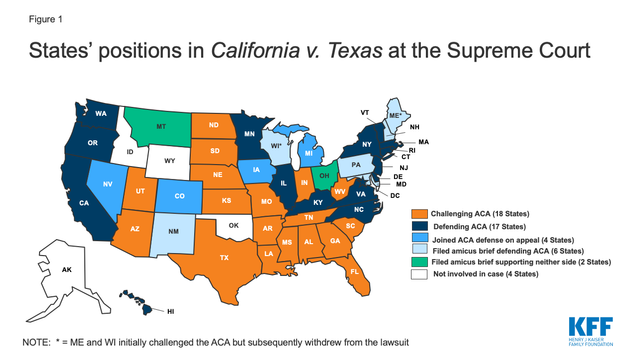 California v. Texas will be a test to the legislative muster of the ACA. With the recent confirmation of Justice Amy Coney Barrett to the Supreme Court, concerns of the ACA being overruled have surfaced as Justice Barrett has claimed that Chief Justice Roberts has “pushed the Affordable Care Act beyond its plausible meaning to save the statute.” The fate of the ACA hinders on whether the individual mandate is unconstitutional, and if so, if the individual mandate of the ACA is severable from the rest of the legislation. If the court does decide to overrule the ACA in its entirety, we may see more than 20 million individuals lose health care insurance, exacerbating the already grim public health crisis brought on by COVID-19, impacting our most vulnerable communities who struggle to gain access to health care.
California v. Texas will be a test to the legislative muster of the ACA. With the recent confirmation of Justice Amy Coney Barrett to the Supreme Court, concerns of the ACA being overruled have surfaced as Justice Barrett has claimed that Chief Justice Roberts has “pushed the Affordable Care Act beyond its plausible meaning to save the statute.” The fate of the ACA hinders on whether the individual mandate is unconstitutional, and if so, if the individual mandate of the ACA is severable from the rest of the legislation. If the court does decide to overrule the ACA in its entirety, we may see more than 20 million individuals lose health care insurance, exacerbating the already grim public health crisis brought on by COVID-19, impacting our most vulnerable communities who struggle to gain access to health care.
Disparities on Minority Care and COVID-19 Infection.
Racial and ethnic minority groups face the greatest barriers to health care access, and, in turn are more likely to be uninsured or underinsured compared to their non-Hispanic white counterparts. While the ACA had greatly reduced the proportion of racial and ethnic minorities who lack health insurance, there are numerous systemic and social hurdles that have left these minority groups uninsured at higher rates than white individuals. As a consequence, racial and minority groups have been disproportionately affected by COVID-19, with racial minorities being over 2.6 times as likely to contract COVID-19, with rate of hospitalization for African American individuals being 4.7 times more than that of white individuals. Not only this, but the mortality rate is 2.1 times that of white people in the US, showing clear disparity in treatment outcomes and access to treatment.
The disproportioned access to health care services from racial and ethnic minority groups, has undoubtedly put these individuals at higher risk to unexpected out-of-pocket expenses, surprise bills, and physical harm from COVID-19. COVID-19 has shed light on the systemic racism in our health care system, unfortunately adding to the already disastrous public health crisis. The many cracks that are forming throughout our health care system will have untold effects on minority populations, and needs to be addressed through comprehensive legislative health care reform that is aimed at providing universal insurance coverage and eliminating implicit biases that contribute to lower standard care.
While the sprawling costs of COVID-19 stand out as clear reminders that we are living anything but a normal life, the true long term costs on minority populations, health care institutions, and health care access is now even more clear as Americans face another wave of COVID-19 outbreaks during these colder months. This cocktail of failures will greatly impact an already fragmented health care system, leaving our most vulnerable communities without proper health care access. Congress and the state legislatures need to secure funding for the providers of our health care services, while also increasing access to health care insurance and treatment for all individuals to minimize the long-term costs associated with COVID-19.
 Kyle Hafkey anticipates graduating from Boston University Schoo of Law in May 2022.
Kyle Hafkey anticipates graduating from Boston University Schoo of Law in May 2022.
COVID-19 is a Perfect Opportunity to Reinvent America’s Mass Public Transit
As the coronavirus (Covid-19) has swept the globe, its impact on global health has been massive. However, this pandemic is not only wreaking havoc on the world’s physical health, but also its financial health. Throughout March 2020, as governments globally imposed restrictions on movement and on business, stocks plummeted. In response, the Federal Reserve slashed interest rates and has attempted to provide new sources of funding for business. Additionally, the federal government enacted a $2 trillion stimulus package. This package includes direct aid for businesses as well as individuals, in addition to support for the medical industry and other key parts of the economy. However, this bill merely provides a one-time cash infusion for a struggling and increasingly desperate economy. The US approach differs from what other countries have provided their citizens during this crisis. Other methods are more akin to ongoing support rather than a one-time payment. In fact, the UK government, in an attempt to curb unemployment, has promised to subsidize up to 80% of any worker’s salary who is facing unemployment, up to $2,900 a month. Many other countries have followed this model of providing continuing support to workers and businesses in an effort to limit unemployment. This is in contrast to the United States where, even after this stimulus was enacted, unemployment figures in the United States have climbed precipitously. Consequently, there have been discussions in Washington of a large infrastructure spending bill, akin to several New Deal programs, that would create thousands of jobs to help the United States economically recover as the health crisis recedes.
It has been reported that this infrastructure bill could be a multi-trillion dollar project. However, it is not clear that an agreement will be reached. For the duration of the Trump Presidency, infrastructure has been seen as a potential compromise issue that both Democrats and Republicans could support, yet an agreement has been elusive. Earlier this year, House Democrats released a proposal that would direct $760 billion towards rebuilding American highways, airports, and other infrastructure, with $10 billion going towards building community health centers. Additionally, this proposal included $329 billion for transportation systems, including $105 billion for transit agencies and maintenance. However, Trump and Congressional Democrats were not able to agree on a compromise agreement. Now that there is increased political pressure to provide jobs, an infrastructure deal is more likely than ever to occur. When it does, Congress should include vigorous funding specifically for mass transit.
First, the construction of mass transit can achieve the short term goal of the infrastructure bill: to create jobs. In fact, a recent light rail construction project between Durham County and Orange County in North Carolina was projected to create 20,000 jobs at a cost of just $2.5 billion. While it is unlikely that these job returns per investment would hold constant, these numbers suggest that a $1 trillion investment could yield 8,000,000 jobs. This would put a sizeable dent in to projected 20 million unemployment claims that could be filed as a result of the pandemic and subsequent economic downturn.
However, the United States should not throw money at a short term solution, without considering long term objectives as well. Investment in mass transit not only would result in short term jobs, but it would also yield many long term benefits that would impact society for a substantial period of time.
Studies at Harvard University indicate that commuting time is the single strongest factor in predicting the odds of escaping poverty. While this may be a function of poverty inherently being a hard burden to escape and wealthier individuals live near good transit options, this may not be the sole explanation. After housing, transportation is the biggest expense for most Americans, especially those settled along the urban fringe. In fact, 44% of all multifamily section 8 properties in the nation spend on average more than 15% of their income on transportation costs, effectively making these properties unaffordable. Yet increased availability of mass public transit could help solve this issue. Undeniably, mass transit is cheaper than the alternative: owning a car. On average a household can save around $10,000 annually by owning one fewer car and utilizing public transit.
However, American mass transit systems lag behind those of other countries. New York is the only US city where rail network ridership has increased since 2012. North America as a whole only accounts for 3.7 billion of the world’s 53 billion rail passengers. Ridership in Asia increased to 26 billion between 2012 and 2017, Europe accounts for 10 billion riders, and Latin America 6 billion. Further, American cities with popular transit systems are generally located in the north and on the coasts of the country. While many attribute this lack of public transit to America’s sprawl, a look at Canada, an equally car centric country, dispels this theory. Toronto, Montreal, and Vancouver all have buses, rapid transit, and commuter rail systems. Rather, reports have postulated that American mass transit systems have failed to gain steam because the demand for them is not present, and American’s would rather drive. Further, demand could be low because in cost cutting efforts, many bus and rail lines run less than once every 30 minutes. This lack of service restricts people’s lives in such a way that anyone who can drive, will drive.
Therefore, as Congress and the President work out an infrastructure bill in the coming days and weeks, they should invest heavily in mass public transit. Not only will this plan help solve the initial goal of providing jobs to those left unemployed by COVID-19, but it will also provide significant long term benefits to lower income groups. However, this bill must also create a framework to continue to support mass public transit projects. While it is undoubtedly beneficial to build these projects, their long term impact can only be realized if they are funded sufficiently to become a viable and preferable option to cars. Legislators must ensure that this massive expenditure is structured in a way that it can provide lasting change and provide more benefits than a one time influx of cash ever could.
 Gray Louis anticipates graduating from Boston University School of Law in May 2021.
Gray Louis anticipates graduating from Boston University School of Law in May 2021.
Funding the MBTA: Getting Derailed Plans Back on Track
Taking the T
The transit system of Eastern Massachusetts, governed by the Massachusetts Bay Transportation Authority, has been the subject of much ire by residents of Greater Boston for decades, particularly where the subway, or “T,” is concerned. A prime example is last year’s decision to raise fares by 6% despite continual failures in service, such as a recent derailment on the Red Line and power shutdown on the Blue Line. As the oldest subway system in North America, many of the T’s problems stem from decades- or even century-old design decisions which are impractical to redo today. For example, its hub-and-spoke layout emphasizes access to downtown Boston at the expense of ease of travel between the edges of the system.
Broke, But Not Broken
However, the primary barrier to the T being the efficient, functional transit system that Boston needs it to be is insufficient funding relative to necessary maintenance and upgrades, not to mention its current debt load. Though the MBTA system as a whole sees more than $2 billion in annual revenue, it still endures annual operating losses of more than $36 million. Significantly, the majority of its revenue does not come from operations, i.e. fares collected, but rather from sales tax and local assessment contributions. For nearly twenty years, a “penny” of all non-meal-and-drink sales tax revenue in Massachusetts has been dedicated to the MBTA budget. Because this source of tax revenue has not grown as anticipated, the MBTA budget has consequentially fallen short of expectations by well over $200 million per year. Meanwhile, costs of new projects continue to balloon. The cost of an upgraded fare collection system, originally budgeted at just over $700 million, has now grown to over $900 million.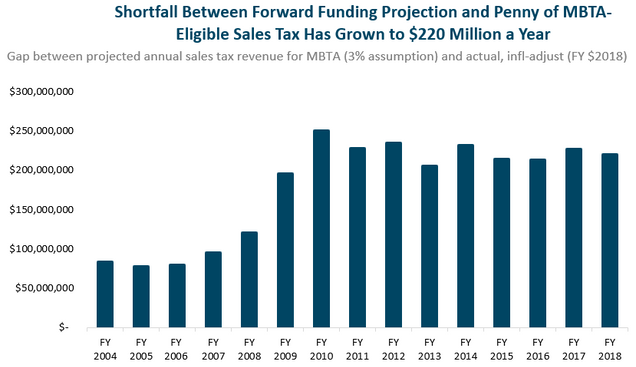
Boston City Councilor Michelle Wu argues that incremental fixes and patching of problems is insufficient; rather, we must invest in the system as a whole with a focus on expanding access. The necessity of serious capital investment became especially apparent after historic blizzards in early 2015 forced a system-wide shutdown. Wu has pointed to Governor Charlie Baker’s reluctance to act as an obstacle to the requisite overhaul the T needs. In response to pressure from her and other transit advocates, last summer Gov. Baker announced plans to accelerate an ongoing five-year, $8 billion capital investment program which kicked off in early 2019. The program aims to provide new rapid-transit buses and train cars, modernize the Red and Orange Lines, and fund a major expansion of the Green Line into underserved areas of Somerville and Medford. The latter, a long-suffering project decades in the making, is an example of the importance of major investment in transit: once complete, the percentage of Somerville residents within walking distance to light rail will increase to 80%, up from a current 20%. Gov. Baker’s acceleration includes more aggressive closures to allow for infrastructure work, more inspections and maintenance, negotiations with contractors, and the creation of a new team of MBTA personnel with the flexibility to work on multiple projects.
Capital Infusions
Even so, continued problems, such as the aforementioned Red Line derailment, prompted Gov. Baker to propose an $18 billion bond bill for transportation throughout the Commonwealth last year, providing money to the entire Massachusetts Department of Transportation, including a $5.7 billion slice for the MBTA. This bill, An Act Authorizing and Accelerating Transportation Investment, most recently received approval, with an amendment, from the House Committee on Bonding, Capital Expenditures and State Assets and moved before the House Committee on Ways and Means in late February, 2020. This Act would fund road and bridge repairs, MBTA upgrades, and the electrification of regional transit services, as well as contribute to big projects such as Cape Cod Canal bridges and the Green Line Extension. The bill also provides support for improving pavement on public roads and building small bridges as well as help for municipalities seeking to make their roads more cyclist- and pedestrian-friendly. Other provisions aim to reduce traffic congestion and greenhouse gas emissions by building bus lanes and working to reduce bottlenecks. Transportation Secretary Stephanie Pollack highlighted the importance of action on other projects which complement improved transit service to maximize the impact of the bill. Such legislation includes Gov. Baker’s proposed Housing Choices Act, which would streamline zoning approval for certain housing projects.
This past January, Gov. Baker also proposed a $135 million budget increase for the MBTA, possibly in response to a scathing December 2019 report by the Safety Review Panel which found deficiencies “in almost every area” of the MBTA system. A major criticism was the recent over-emphasis on capital improvements and not enough support for regular maintenance and safety, with staff being diverted away from the latter. However, it is unclear how exactly the infusion of funding would be spent.
It should be noted that there currently remain $743 million in outstanding senior revenue bond loans to MassDOT, though the Department maintains an A+ rating for borrowing. Though the Act Authorizing and Accelerating Transportation Investment would be funded by further borrowing via bonds, its original version allocated half of all revenue from a potential greenhouse gas cap-and-trade program with other states in the region to public transit, creating a stream of revenue as well as encouraging more fuel-efficient cars. However, that provision was stricken by the Transportation Committee, which argued that they cannot allocate funds to a program that does not yet exist. Lawmakers instead plan to increase fees on transportation network companies and deeds excise taxes.
COVID-19 Crisis
The amendments, including those made earlier by the House Committee on Transportation, include the elimination of $50 million in business tax cuts to encourage employees to work from home and thus reduce traffic congestion, a quaint decision in the midst of the COVID-19 pandemic which has forced millions to work from home anyway. The MBTA has been understandably hit hard, and as of April, ridership on the T was down more than 90% from late February, with bus service down nearly 80%. Anticipated losses this year exceed $213 million due to a 95% plunge in fare collection and drops in revenue from advertising and state sales tax. MassDOT hopes to cover the loss with an expected infusion of $840 million in federal funds through the CARES Act. Meanwhile, the MBTA has reduced service, instituted cleaning and sanitizing regimes for vehicles, and has begun requiring employees and remaining riders to wear face masks.
Needless to say, major investment decisions as of this writing have been put on hold. However, once this crisis has passed, it is critical that Massachusetts act to ensure its transit services remain a functional asset to the people of the Greater Boston Area and beyond.
 Kellen Safreed anticipates graduating from Boston University School of Law in May 2021.
Kellen Safreed anticipates graduating from Boston University School of Law in May 2021.
Post Haste: Why Reform of the US Postal Service is a Matter of Urgent National Concern
President Trump has been antagonistic to the United States Postal Service since the early days of his administration. In his plan for government reorganization, he called for the privatization of the post office. He has tweeted that the post office should charge Amazon more to deliver packages. Most recently, he has threatened to veto COVID-19 emergency funding if it contains direct funding for the post office.
 Ultimately, change is needed with regard to the postal service. However, that change needs to be an expansion in the role of the post office in public life rather than a diminution of its functions. Because the postal service has a universal service obligation to provide all aspects of service at an affordable price to all communities in the United States, it already represents a vital service to thousands of Americans who are not perceived as “profitable” to serve by private companies. Leveraging that power by expanding the role of the postal service can be a powerful boon to democracy and an agent of financial inclusion for underserved communities. Pending legislative proposals exist to address these concerns, and urgent action is needed. These proposed expansions to the role of the postal service require an additional legislative intervention to support its financial viability. To increase access, facilitate participation, and promote strong and healthy communities, three key legislative reforms to the post office are urgently needed.
Ultimately, change is needed with regard to the postal service. However, that change needs to be an expansion in the role of the post office in public life rather than a diminution of its functions. Because the postal service has a universal service obligation to provide all aspects of service at an affordable price to all communities in the United States, it already represents a vital service to thousands of Americans who are not perceived as “profitable” to serve by private companies. Leveraging that power by expanding the role of the postal service can be a powerful boon to democracy and an agent of financial inclusion for underserved communities. Pending legislative proposals exist to address these concerns, and urgent action is needed. These proposed expansions to the role of the postal service require an additional legislative intervention to support its financial viability. To increase access, facilitate participation, and promote strong and healthy communities, three key legislative reforms to the post office are urgently needed.
Postal Banking
The first potential legislative reform is the reintroduction of postal banking. Prior to 1967, the post office served an important role in providing basic financial services to thousands of Americans in rural and underbanked communities. Because the post office is a universal service, ensuring access to reliable mail service everywhere in the country, it was uniquely situated to ensure access to financial services like access to small loans, checking and savings accounts, and basic transactional services to communities not deemed profitable for traditional financial institutions to serve.
In 2017, 6.5% of households in the United States, or nearly 8.5 million households, were unbanked – meaning they had no formal bank account—and an additional 24.2 million were underbanked. These individuals are therefore forced to fringe or informal financial institutions, which often more costly to them because of high interest rates and lack the federal protection and oversight of traditional financial service providers. Re-establishing postal banking would create a formal institution to serve the basic financial needs of these communities, allowing them a greater degree of financial inclusion and economic participation without resorting to check cashers, payday lenders, or other informal actors.
Postal banking is a popular proposal with a historical precedent that can be reenacted to improve economic and financial inclusion for marginalized communities. Senator Gillibrand introduced legislation in 2018 to allow the postal service to conduct limited financial activities, but the bill was never heard in committee. Passing legislation similar to Senator Gillibrand’s bill would represent a key step toward improving access to financial services, and therefore financial inclusion and economic participation, for marginalized communities.
National Vote-By-Mail
The next key legislative reform to the postal service must be a federal move to facilitate national vote-by-mail. Election law is a largely a matter of state law, as states are empowered to set the particulars of elections within their jurisdiction subject only to minimal Constitutional requirements. States can and have taken the lead on expanding vote-by-mail; according to the National Council on State Legislatures, five states conduct all elections entirely by mail, and another three states allow counties to opt into vote-by-mail for all elections. In total, 21 states allow vote-by-mail elections in some capacity. However, the crisis of the novel coronavirus outbreak has underscored the need to take federal action as evidenced by the Supreme Court’s refusal to extend the deadline for absentee ballots in Wisconsin’s April election and the at least 36 resulting cases.
Senator Klobuchar introduced legislation that, among other things, would allow for expanded absentee vote-by-mail in every state during emergency conditions. While the legislation represents a good first step towards federal action on uniform access to vote-by-mail, it is limited to declared emergencies and therefore does not go far enough. In order to manifest the full benefits of vote-by-mail – most notably increased ease of and access to voting, therefore increasing turnout and civic participation – a more comprehensive bill is needed. The Universal Right to Vote by Mail Act of 2009, which would have made it easier to vote by mail by prohibiting states from imposing additional requirements on vote-by-mail eligibility, represents the kind of sweeping, permanent reform that is necessary to facilitate broad access to voting, and therefore civic and democratic participation, among all communities in a safe and healthy manner.
Removing the Pension Prefunding Requirement
For the benefits of these reforms to fully manifest, it is crucial that the post office is financially viable. This requires a final legislative reform – removing the pension prefunding requirement imposed on the postal service in the Postal Accountability and Enhancement Act of 2006 (PAEA).
While advocates of privatization claim that the post office is losing money, those claims fail to capture the full context of the legal predicament faced by the office. PAEA requires the postal service to prefund employee pensions until 2056, a requirement imposed on no other federal agency. Removing this requirement and allowing the post office to adopt the pay-as-you-go model used by the private sector and other federal agencies would result in over $5 billion in additional cash flow to the service. In order to support the other changes to the role of the postal service, this prefunding requirement must be lifted. This would allow the postal service to remain financially viable in its greater capacity without requiring service price increases.
These reforms have champions, including Senator Gillibrand who continues to speak out vociferously in support of the postal service and its potential to facilitate civic and economic participation and to improve access and inclusion for communities across the country. The trio of reforms described here would raise the profile of the postal service and increase its role in the lives of thousands of people across the country. With the reintroduction of postal banking and expansion of voting by mail, a financially bolstered United States Postal Service can support strong communities in a way that private industry has been unwilling or unable to do. Decades of financial exclusion and disinvestment in rural and low-income neighborhoods and the global crisis of the coronavirus have demonstrated that we, as a country, cannot wait to act. Reinvigorating the postal service and its role in society are of urgent national concern.
 Jordan Neubauer anticipates graduating from Boston University School of Law in May 2021.
Jordan Neubauer anticipates graduating from Boston University School of Law in May 2021.
Arizona’s Teacher Strikes: The End or Just the Beginning?
For six school days in late April and early May, teachers across the state of Arizona walked out of their classrooms to demand better pay, more classroom funding, and other concessions from governor Doug Ducey (R) and the Republican-controlled state legislature. These teachers, inspired by similar walk-outs in West Virginia, Oklahoma, and Kentucky, brought their “outside voices” together to call for change. In the early morning hours of May 3, Ducey signed the new state budget that gave teachers a raise. But, the bill fell short of meeting the walkout organizers’ other demands. Some have said the #RedforEd movement failed because it did not deliver on all of the group’s demands. Still, this strike was just the beginning.
It is important for me to be transparent about my personal connections to this issue. My mother is a life-long public school teacher, who recently retired after over 25 years of teaching in schools across Arizona. As part of Teach for America, I spent three years teaching in the Littleton Elementary School District, the same district where #RedforEd organizer Noah Karvelis teaches, although Mr. Karvelis started teaching after I left for law school. During my first two years of teaching, I earned my Master’s degree in secondary education from Arizona State University. And while I moved across the country to attend law school in Boston, I have kept in touch with many of my former colleagues in Arizona.
The issues with education funding in Arizona started in 2008, while the country was reeling from the recession. As states across the country scrambled to fix their budgets, Arizona’s schools took a big hit. Ten years later, while the economy has recovered, funding for Arizona’s schools didn’t. According to a report by the state’s auditor, schools were receiving less inflation-adjusted dollars per student in 2017 than they were in 2008. During that time, the state has seen its income limited by a number of tax cuts, the largest of which have gone to corporations. Despite promises, economic research has indicated that the cuts have not stimulated economic growth, resulting in decreasing government revenue. All this has translated into horrible conditions in many schools across the state.
The combination of the lowest teacher salaries in the country, low education funding, and successful walkouts in other states urged Arizona’s educators to take action. The group Arizona Educators United, which started the #RedforEd movement, laid out five demands: 20% raises for teaching & certified staff; pay raises for classified staff (janitors, paraprofessionals, secretaries, etc.); restoring classroom funding to 2008 levels; no new tax cuts until Arizona’s per-student funding reaches the national average, and annual raises for teachers until salaries reach the national average.
The movement’s hashtag, #RedforEd, started as a way to draw attention to the lack of education funding. Teachers began with “walk-ins” – they arranged to arrive at school early and stand just outside their school’s gates, wearing red shirts and waving signs. The walk-ins were aimed at building community support. Teachers also protested outside the capital during a “teach-in” on March 28 after the school day ended. The walk-ins continued for another month and, when the state legislature wasn’t receptive, the strikes began on Thursday, April 26.
After nearly 13 hours of debate, Governor Ducey signed a new state budget that included nearly $273 million for teacher pay raises. That will only amount, however, to a 9% raise this year. Governor Ducey has plans to provide 5% raises in each of the next two years, in addition to the 1% raise teachers saw at the start of the last school year. But, this plan has a big problem. The legislature passes a new budget each year. So, while Ducey has “plans” to provide a 20% raise by 2020, that plan is completely out of his control because the decision ultimately lies with the legislature.
There are a number of other concerns that the teachers have with Ducey’s deal. The budget does nothing to raise per-pupil spending, increase pay to support staff, or reduce the state’s student-to-counselor ratio. While the American School Counselor Association recommends a ratio of 250 students per counselor, Arizona averages 924 students per counselor. A Democratic representative, Mitzi Epstein, had offered an amendment that would mandate a 250:1 student-to-counselor ratio, but the amendment failed.
While the budget itself certainly contained far less than #RedforEd supporters had hoped for, the fight is far from over. There are a number of ballot measures this November that could take Arizona’s education system in radically different directions. First, Proposition 305 asks voters whether they want to keep Senate Bill 1431 in place. That bill expanded what are formally called “Empowerment Scholarship Accounts” (“ESAs”) but more commonly known as school choice “vouchers.” While the two terms are not mere synonyms because they allocate money somewhat differently, the net result is that ESAs may be used by parents to send their child to private schools (including religiously affiliated schools). The money for ESAs is taken from public schools which, as stated, are grossly underfunded.
Organizers are also seeking petition signatures to place another initiative on the ballot related to education funding. The “#InvestInEd” ballot measure, which has not been given a number yet because it is not yet formally on the ballot, calls for tax increases on income over $250,000 for individuals or $500,000 for married couples. The web page in support of the ballot measure states that “[t]he higher rates are only paid on the income above those amounts.” Perhaps most importantly, funding secured through a ballot measure such as this one “cannot be taken away by the legislature.”
Finally, the #RedforEd movement has even driven some teachers to take more direct action. After spending nearly a week at the Capitol pleading with legislators to take action, several educators are running for elected positions themselves. The article by the Arizona Capitol Times identified former teachers running as both republicans and democrats for positions in the state house and senate, as well as local school boards.
The flurry of activity around education funding in Arizona makes a bold statement: this issue is not going away. While the strikes may be over and the new budget is signed, teachers have made clear that this will be a big issue come November. Beyond the ballot initiatives and teachers running for elected office, Governor Ducey is up for reelection. The #RedforEd movement unquestionably fell short of their goals – the last answer on the Arizona Educators United “FAQ” page makes that clear. But, to say that the movement died when the strikes ended is to underestimate the political will of angry teachers. Time will tell, but I think the movement for education improvement in Arizona is far from over.
David Bier anticipates graduating from Boston University School of Law in May, 2019.
Finding Equity in Mental Health Reform
Mental health has been a very serious topic in recent years, and one of growing concern in American society. Mental illness among teenagers continues to rise, and so do the costs of mental health treatment. Health care in general is a major and complicated issue in the United States, as Republicans in Congress found in their attempts to repeal and replace the Patient Protection and Affordable Care Act (“ACA”). In recent decades federal and state legislation have greatly improved access and provided needed consumer protections, but many of the most important protections are in jeopardy. If current Congressional action is any indication, mental health reform may take several steps backward under the new administration.
Mental health reform became a federal issue in 1996 when Congress passed the Mental Health Party Act (“MHP”). It was a weak first attempt at fixing persistent problems in the American health insurance market. Up until the passage of the MHP, insurance providers openly discriminated against mental health claims and treatment. The MHP was the federal government’s attempt to address the disparity between mental health coverage and traditional medical/physical health coverage. However, the original MPH was gutted in Congress before passage, leaving behind a weak law that barely fixed disparities and discrimination in mental health coverage.
During the congressional debates to get the MHP passed, many were concerned about the economic and practical costs of the initiatives to provide equal protections for mental health and medical care. However, the major success of the MHP was that it demonstrated to lawmakers that providing coverage for mental health treatments was not only beneficial, but that it could be done in a cost effective manner.
After the passage of the 1996 Act, the states responded and attempted to bridge some of the gaping holes left by the MHP. In many cases, states created stricter mental health parity laws than the federal government. This sparked a general acceptance and trend toward improving mental health parity. As opposition to mental health parity was drowned out by support for increased regulation and consumer protections, Congress felt encouraged to try their hand again at providing equal treatment for mental and medical health coverage. The 2008 Mental Health Parity and Addiction Equity Act (“MHPAEA”) was the result of Congress’s second try. The MHPAEA greatly expanded protections for mental health patients and treatment coverage. But alas, there were still major areas in need of reform.
Of particular importance to the current and future state of mental health reform though, came two short years after the passage of the MHPAEA - the ACA. Passed in 2010, the ACA combined with the MHPAEA brought sweeping reform for mental health coverage. Mental health coverage falls under the Essential Health Benefits mandate requiring every insurance provider to provide consumers with mental health coverage. Coupled with the MHPAEA, which requires any insurance provider to treat mental and medical claims equally, mental health coverage is now equal in the eyes of the law to medical coverage.
Since the passage of the ACA though, the practical impact of the reforms have resulted in more covert discrimination of mental health claims that are chipping away at important health care resources that are increasingly vital in American society. Despite laws requiring equal treatment, insurance providers decline mental health claims at higher rates than medical claims. Additionally, insurance providers also make it hard for mental health treatment providers to get paid thereby limiting the physical amount of help available.
The ACA made significant gains in mental health reform, however the lack of practical results has preserved mental health reform as a serious issue of concern. Recently, Congress enacted the 21st Century Cures Act (“Cures Act”), which addresses many pressing concerns that were not covered under the ACA. Most notably, the new act uses modern ideas to address mental illness concerns and substance abuse issues. However, a major concern with the Cures Act is that despite its passage, the House must choose to fund it. Otherwise, all the legislative action prescribed by the new federal law is moot.
Unfortunately, many are speculating that Congress and the Administration will be at odds over the budget putting federal funds for mental health in jeopardy. This is especially so given the fight over funds for various Republican and Presidential pet projects. For example, the President is strongly urging the Republican controlled Congress to allocate funding for his pet project, the border wall between the United States and Mexico. However, House Speaker Paul Ryan and many Republican representatives are more interested in changing funding allocations for health care in an attempt to bounce back after the humiliation of their previous attempt at altering the ACA.
If the recent efforts to "repeal and replace" the ACA was any indication of what the future holds for mental health reform, then America will take a step backward leaving millions without coverage thereby exacerbating an already growing problem. The House passed AHCA attempted to gut the ACA, and would have remove the individual mandate and significantly altered the Essential Health Benefits requirement. Under the AHCA, Ryan tried to remove the requirement that Medicaid and Medicare must follow the Essential Health Benefit mandate, which would effectively prevent millions of the most vulnerable in society from accessing affordable mental health resources.
The fate of mental health coverage and treatment access in many ways is tied to the continued success and longevity of the ACA and funding options for current mental health legislation. To remove the current federal mental health protections, as was proposed in the AHCA, would set progress back and make it nearly impossible for millions to have access to affordable mental health treatments. As the need for mental health treatments and resources grows, we as a nation should not be removing protections and federal funding for progressive initiatives. We should continue to follow the path of the Cures Act and further pursue these initiatives. In order for mental health treatment to be improved subsidies need to be provided for mental health treatment providers (such as psychologists) to incentivize them to open practices and facilities in critical shortage areas. Additionally, federal and state regulations need to address the manner in which insurance providers treat mental health providers.
The current legal framework as a whole is very fair, but needs stricter enforcement on the ground. What use are laws and protections if no one is incentivized to follow them? Of the greatest important, however, is that future laws and regulations intending to improve the state of mental health coverage need to stop attempting to create equality between mental health and medical treatment. Medical and surgical procedures are inherently different than mental health procedures and thus legal equity is needed in order to improve access and provide needed consumer protections.
Is There Such a Thing as Free College?
New York became the first state to make tuition free for two- and four-year colleges for certain students. Governor Andrew Cuomo first introduced his Excelsior Scholarship plan in January 2017, and signed it into law in April 2017. New York State’s Excelsior Scholarship will provide free tuition to students whose families earn less than $125,000 for all public two- and four-year colleges in New York, covering State University of New York (SUNY) colleges as well as City University of New York (CUNY) colleges. The estimated cost if this Excelsior Scholarship is $163 million, amounting to only 0.1% of New York State’s budget. Governor Cuomo, in announcing his plan, said “In this economy, you need a college education if you’re going to compete.” He explained, “It’s incredibly hard and getting harder to get a college education today. It’s incredibly expensive and debt is so high it’s like starting a race with an anchor tied to your leg.” Based on projections, around 940,000 New York households have college-aged children who would qualify for the program.
“[T]he cost of attending college has risen at a much faster rate than the median income, putting even middle-class families in a tough spot when trying to figure out how to finance their children’s college education.” According to the Institute for College Access and Success, about 59% of students graduate from New York’s four-year colleges with debt, on average about amounting to $29,320 of debt. The program will work by giving a scholarship to students whose existing federal and state need-based loans do not fully cover the $6,470 list price tuition at public institutions. Students who currently pay no tuition out of pocket because they receive enough financial aid, through Pell Grants or New York Tuition Assistance grants, to cover tuition, will not receive any funding from the Excelsior Scholarship. This is problematic, as the Scholarship targets students from middle income families, instead of helping students from lower income families who struggle to pay for living expenses, books, and transportation even though they may not be paying out-of-pocket for tuition. Additionally, in order to be eligible for the Excelsior Scholarship students must enroll in 30 credits per year, therefore excluding part-time students.
Added to New York’s law at the last minute, just before it was signed, was a clause that turns the scholarship into a loan if the student leaves the state within four years of graduating (assuming they received four years worth of funding). This subsidy-turned-loan is problematic for many reasons. It both impedes the ability to work in the national labor market, as well as could incentivize unemployed graduates to stay in New York rather than leave the state to find a job elsewhere. Additionally, the converted subsidy-turned-loan would not have the same benefits as a federal student loan, like the income-based repayment arrangement.
Some of New York State’s public officials were not thrilled with the plan. New York State Assembly Republican Leader Brian Kolb stated “Governor Cuomo isn’t providing ‘free’ tuition, he’s simply telling New York taxpayers to write a bigger check.” Other Republican lawmakers criticized the Governor’s proposal during budget negotiations for excluding students at private colleges. Additionally, while SUNY Chairman Carl McCall and Chancellor Nancy Zimpher “applauded the budget deal” and called it “truly ground-breaking,” they also had “hoped for additional support,” specifically for SUNY community colleges.
With this program, New York joins other states and cities in providing free college. Tennessee, Oregon, and San Francisco have recently made tuition free at community colleges for all residents, regardless of income. Additionally, Rhode Island is now considering a proposal that would make two years at public colleges tuition-free. Unlike the Excelsior Scholarship in New York, the proposal in Rhode Island would allow every Rhode Island resident who graduates high school in-state to be eligible for two-years free tuition at the University of Rhode Island, Rhode Island College, and the Community College of Rhode Island, regardless of income. Interestingly, the Rhode Island proposal makes it so the scholarship could only be used for a students’ junior and senior years at four-year colleges. Projections from the Rhode Island Governor’s office expect that the program would benefit 8,000 students and cost $30 million a year, less than 0.5% of the state’s budget. The proposed plan, a “last dollar” scholarship, would “cover the gap a student has on their tuition bill after using up any federal or state grants he or she already receives.”
Additionally, college tuition has been a topic on the federal level. President Trump has proposed cutting $5 billion in higher-education for lower-income Americans. Senators Bernie Sanders and Elizabeth Warren, along with Representative Keith Ellison and other members of Congress, introduced the College for All Act, with the hope to eliminate tuition and fees at public four-year colleges and universities for students whose families make under $125,000 per year. The bill proposes that the federal government would pay 67% of tuition subsidies at public colleges and universities, and state and tribal governments would pay the other third. While the bill likely will not pass with a Republican Congress and Trump in the White House, it has been backed by the United States Students Association, the American Federation of Teachers, and the National Education Association.
While these college tuition subsidies could be extremely beneficial in allowing more students to attend college who previously could not afford it, there are many controversial issues in the scholarship plans. Who ends up paying for the scholarship? Does college truly prepare graduates for the workforce? And lastly, with all the strings-attached to New York State’s Excelsior Scholarship, can it be said that there is such a thing as free college?




